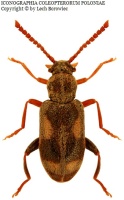Підтримуємо Вільну Україну
 We Support Free Ukraine
We Support Free Ukraine

Biodiversity Map
Taxa

Phytobaenus — subordinate taxa:
Taxon count: 2
-
Arthropodaphylum
Click to switch
to select orders
and filters > -
Hexapodasubphylum
Click to switch
to select orders
and filters > -
Insectaclass
Click to switch
to select orders
and filters > -
Coleopteraorder
Click to set
as the main taxon
and as a base
← of the left panel > -
Polyphagasuborder
Click to set
as the main taxon
and as a base
← of the left panel > -
Cucujiformiaseries
Click to set
as the main taxon
and as a base
← of the left panel > -
Tenebrionoideasuperfamily
Click to set
as the main taxon
and as a base
← of the left panel > -
Aderidaefamily
Click to set
as the main taxon
and as a base
← of the left panel > -
Phytobaenusgenus
Click to set
as the main taxon
and as a base
← of the left panel > -
Phytobaenus amabilisspecies
Click to set
as the main taxon
and as a base
← of the left panel >
PL
YES
name status: valid name
BioMap ID: 1022166
taxon code: 3902
taxonomy checked: YES
Data on distribution in Poland

Statistics
- Records: 47
- Publications: 23
- Collections: 6
- Publication authors: 28
- Illustrations (iconography): 1
- Photos (specimen/observation): lacking
Taxon description
Szeroko rozprzestrzeniony gatunek eurosyberyjski, na wschód docierający do Amuru i Japonii; w Europie znany głównie ze środkowej części kontynentu, na południe sięgający po Francję południową i Rumunię, a na północ do południowych prowincji w Szwecji i Finlandii. W Polsce chrząszcz bardzo rzadki, znany tylko z sześciu krain. Pojaw postaci dojrzałych rozpoczyna się wczesną wiosną i trwa do lipca. Chrząszcze poławiano na drzewach liściastych, pod odstającą korą, na trawach łąk śródleśnych w sąsiedztwie starych drzew, w których prawdopodobnie odbywają rozwój w zmurszałym drewnie.
Illustrations
... browse
 Phytobaenus
Phytobaenusamabilis
amabilis
External data sources
- Ostatnie rekordy
-
1072566
 ⊡
⊡ Aderidae: Phytobaenus amabilis amabilis, AZ, Talysh Mountains, Lerik rayonu, ad Gosmalyan, 2014, leg. J. Ługowoj
Aderidae: Phytobaenus amabilis amabilis, AZ, Talysh Mountains, Lerik rayonu, ad Gosmalyan, 2014, leg. J. Ługowoj -
928072
 ⊡
⊡ Aderidae: Phytobaenus amabilis amabilis, PL, Bieszczady, Średnia Wieś, UTM EV97, 1935, coll. MiIZ PAN (Jałoszyński et al. 2013a, Kubisz et al. 2014)
Aderidae: Phytobaenus amabilis amabilis, PL, Bieszczady, Średnia Wieś, UTM EV97, 1935, coll. MiIZ PAN (Jałoszyński et al. 2013a, Kubisz et al. 2014) -
928071
 ⊡
⊡ Aderidae: Phytobaenus amabilis amabilis, PL, Bieszczady, Średnia Wieś, UTM EV97, coll. Burakowski B.* (Burakowski et al. 1987, Kubisz et al. 2014)
Aderidae: Phytobaenus amabilis amabilis, PL, Bieszczady, Średnia Wieś, UTM EV97, coll. Burakowski B.* (Burakowski et al. 1987, Kubisz et al. 2014) -
928070
 ⊡
⊡ Aderidae: Phytobaenus amabilis amabilis, PL, Beskid Wschodni, Kopyśno, UTM FA10 (Trella 1930a, Kubisz et al. 2014)
Aderidae: Phytobaenus amabilis amabilis, PL, Beskid Wschodni, Kopyśno, UTM FA10 (Trella 1930a, Kubisz et al. 2014) -
928069
 ×
× Aderidae: Phytobaenus amabilis amabilis, PL, Roztocze, Roztocze (Borowiec et Tarnawski 1983a, Kubisz et al. 2014)
Aderidae: Phytobaenus amabilis amabilis, PL, Roztocze, Roztocze (Borowiec et Tarnawski 1983a, Kubisz et al. 2014) -
928068
 ×
× Aderidae: Phytobaenus amabilis amabilis, PL, Wyżyna Małopolska, Chroberz-Złota, UTM DA68, 1953, coll. MiIZ PAN (Jałoszyński et al. 2013a, Kubisz et al. 2014)
Aderidae: Phytobaenus amabilis amabilis, PL, Wyżyna Małopolska, Chroberz-Złota, UTM DA68, 1953, coll. MiIZ PAN (Jałoszyński et al. 2013a, Kubisz et al. 2014) -
928067
 ×
× Aderidae: Phytobaenus amabilis amabilis, PL, Wyżyna Małopolska, Chroberz-Złota, UTM DA68, coll. Burakowski B.* (Burakowski et al. 1987, Kubisz et al. 2014)
Aderidae: Phytobaenus amabilis amabilis, PL, Wyżyna Małopolska, Chroberz-Złota, UTM DA68, coll. Burakowski B.* (Burakowski et al. 1987, Kubisz et al. 2014) -
928066
 ⊡
⊡ Aderidae: Phytobaenus amabilis amabilis, PL, Wyżyna Krakowsko-Wieluńska, Kraków, Borek Fałęcki, UTM DA24, 1986, coll. ISEZ PAN (Jałoszyński et al. 2013a, Kubisz et al. 2014)
Aderidae: Phytobaenus amabilis amabilis, PL, Wyżyna Krakowsko-Wieluńska, Kraków, Borek Fałęcki, UTM DA24, 1986, coll. ISEZ PAN (Jałoszyński et al. 2013a, Kubisz et al. 2014) -
928065
 ○
○ Aderidae: Phytobaenus amabilis amabilis, PL, Puszcza Białowieska, Białowieski P.N., UTM FD94, 1998 (Byk et al. 2006, Kubisz et al. 2014)
Aderidae: Phytobaenus amabilis amabilis, PL, Puszcza Białowieska, Białowieski P.N., UTM FD94, 1998 (Byk et al. 2006, Kubisz et al. 2014) -
928064
 ○
○ Aderidae: Phytobaenus amabilis amabilis, PL, Puszcza Białowieska, Białowieski P.N., UTM FD94, 2000 (Borowski 2001c, Byk 2001a, Kubisz et al. 2014)
Aderidae: Phytobaenus amabilis amabilis, PL, Puszcza Białowieska, Białowieski P.N., UTM FD94, 2000 (Borowski 2001c, Byk 2001a, Kubisz et al. 2014) - ... more
- Powiązane publikacje
-
Kubisz D., Iwan D., Tykarski P. 2014. Tenebrionoidea: Tetratomidae, Melandryidae, Ripiphoridae, Prostomidae, Oedemeridae, Mycteridae, Pythidae, Aderidae, Scraptiidae. Critical checklist, distribution in Poland and meta-analysis. Coleoptera Poloniae, 2, University of Warsaw – Faculty of Biology, Natura optima dux Foundation, Warszawa.
 selected pages
selected pages Show records
Show records -
Jałoszyński P., Wanat M., Kubisz D., Ruta R., Konwerski Sz. 2013a. A synopsis of the family Aderidae in Poland (Coleoptera: Tenebrionoidea). Genus, 24(2):199-216.
 Show records
Show records -
Byk A., Mokrzycki T., Perliński S., Rutkiewicz A. 2006. Saproxylic beetles – in the monitoring of anthropogenic transformations of Białowieża Primeval Forest. [In:] Szujecki A. (Ed.) Zooindication-based monitoring of anthropogenic transformations in Białowieża Primeval Forest. Warsaw Agricultural University Press, Warsaw. pp. 325-397.
 Show records
Show records -
Kubisz D. 2004d. Chrząszcze (Coleoptera) z wybranych rodzin jako element monitoringu ekologicznego w Puszczy Białowieskiej. Wyniki badań z lat 1993-1999. Leś. Pr. Bad., 4:37-49.
 Show records
Show records -
Byk A. 2001b. Próba waloryzacji drzewostanów starszych klas wieku Puszczy Białowieskiej na podstawie struktury zgrupowań chrząszczy (Coleoptera) związanych z rozkładającym się drewnem pni martwych drzew stojących i dziupli. [In:] Szujecki A. (Ed.) Próba szacunkowej waloryzacji lasów Puszczy Białowieskiej metodą zooindykacyjną. Wydawnictwo SGGW, Warszawa. pp. 333-367.
 Show records
Show records - ... more





